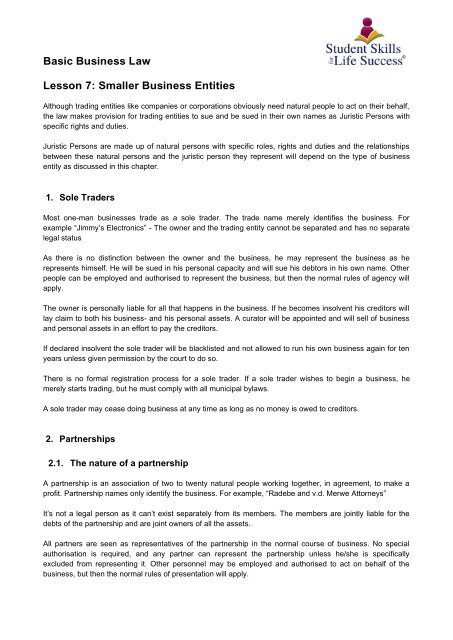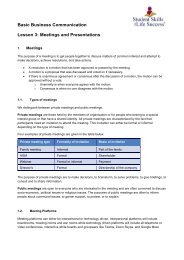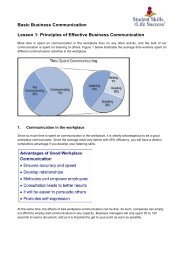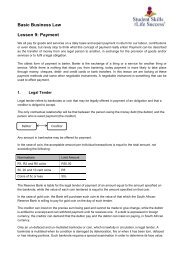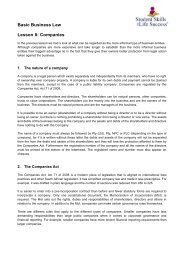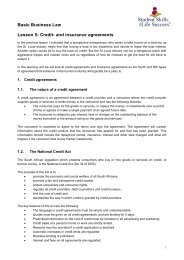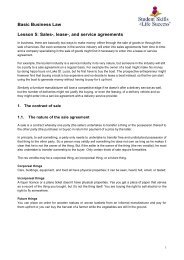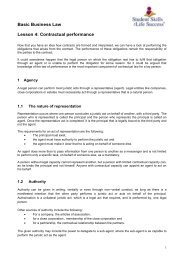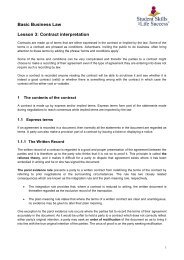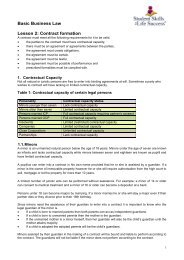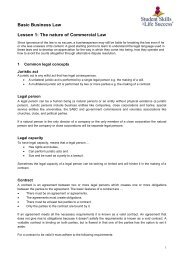Basic Business Law. Lesson 7. Smaller Business Entities
This is the seventh lesson of the "Student Skills for Life Success" "Basic Business Law" course. The topics covered in this booklet are: 1. Sole Traders 2. Partnerships 3. Close corporations 4. Trusts 5. Franchise Agreements
This is the seventh lesson of the "Student Skills for Life Success" "Basic Business Law" course. The topics covered in this booklet are:
1. Sole Traders
2. Partnerships
3. Close corporations
4. Trusts
5. Franchise Agreements
You also want an ePaper? Increase the reach of your titles
YUMPU automatically turns print PDFs into web optimized ePapers that Google loves.
<strong>Basic</strong> <strong>Business</strong> <strong>Law</strong><br />
<strong>Lesson</strong> 7: <strong>Smaller</strong> <strong>Business</strong> <strong>Entities</strong><br />
Although trading entities like companies or corporations obviously need natural people to act on their behalf,<br />
the law makes provision for trading entities to sue and be sued in their own names as Juristic Persons with<br />
specific rights and duties.<br />
Juristic Persons are made up of natural persons with specific roles, rights and duties and the relationships<br />
between these natural persons and the juristic person they represent will depend on the type of business<br />
entity as discussed in this chapter.<br />
1. Sole Traders<br />
Most one-man businesses trade as a sole trader. The trade name merely identifies the business. For<br />
example “Jimmy’s Electronics” - The owner and the trading entity cannot be separated and has no separate<br />
legal status<br />
As there is no distinction between the owner and the business, he may represent the business as he<br />
represents himself. He will be sued in his personal capacity and will sue his debtors in his own name. Other<br />
people can be employed and authorised to represent the business, but then the normal rules of agency will<br />
apply.<br />
The owner is personally liable for all that happens in the business. If he becomes insolvent his creditors will<br />
lay claim to both his business- and his personal assets. A curator will be appointed and will sell of business<br />
and personal assets in an effort to pay the creditors.<br />
If declared insolvent the sole trader will be blacklisted and not allowed to run his own business again for ten<br />
years unless given permission by the court to do so.<br />
There is no formal registration process for a sole trader. If a sole trader wishes to begin a business, he<br />
merely starts trading, but he must comply with all municipal bylaws.<br />
A sole trader may cease doing business at any time as long as no money is owed to creditors.<br />
2. Partnerships<br />
2.1. The nature of a partnership<br />
A partnership is an association of two to twenty natural people working together, in agreement, to make a<br />
profit. Partnership names only identify the business. For example, “Radebe and v.d. Merwe Attorneys”<br />
It’s not a legal person as it can’t exist separately from its members. The members are jointly liable for the<br />
debts of the partnership and are joint owners of all the assets.<br />
All partners are seen as representatives of the partnership in the normal course of business. No special<br />
authorisation is required, and any partner can represent the partnership unless he/she is specifically<br />
excluded from representing it. Other personnel may be employed and authorised to act on behalf of the<br />
business, but then the normal rules of presentation will apply.
2.2. Forming and dissolving a partnership<br />
Partnerships require no formal registration and are created solely by agreement between two or more natural<br />
persons. The agreement that leads to the formation of a partnership is called a partnership deed.<br />
It must be clear that it is the intention of all the partners to form a partnership and that their purpose is to<br />
make a profit. Each partner must contribute something, either financial or a service, to the partnership and<br />
each party has a share in the profits of the partnership.<br />
A partnership may be dissolved if…<br />
• a partner dies, leaves, goes insane, or cannot continue with the partnership.<br />
• the period for which the partnership was specifically created comes to an end.<br />
• the task for which the partnership was specifically set up is completed.<br />
• the partners agree to dissolve the partnership.<br />
• one partner gives notice to the partnership.<br />
• the partnership, or any of the individual partners, is declared insolvent.<br />
A partnership can also be dissolved by a court if there is no likelihood of profit, or the duty of good faith was<br />
breached. For example, a partner awards a contract to a family member, when it was not in the best interest<br />
of the partnership to do so.<br />
2.3. The advantages of a business partnership<br />
While a partnership does not protect the partners from liability, there are many advantages to operating as a<br />
partnership.<br />
One of the main advantages of the partnership is that it makes it easy to do business.<br />
• It is easy to form a partnership, as a simple oral or written agreement brings it into existence.<br />
• It has to adhere to very few legal formalities and is inexpensive to form.<br />
• It is easier to access to funds and resources as some partners may be more credit worthy and their<br />
borrowing capacity may be greater. Additional funding can be acquired by admitting new partners, or<br />
a loan can easily be obtained against the private property of the partners.<br />
Partnerships are more flexible than private companies.<br />
• Partnerships have diverse skills and expertise as each partner’s knowledge, skills and contacts can<br />
be fully utilised.<br />
• Partners who have expertise and skills in different functional areas of business can manage the<br />
business more efficiently.<br />
• It is easy to make operational changes and a partnership can respond quicker to changing<br />
circumstances than companies that tend to have a more bureaucratic structure.<br />
• The partners are more likely to make creative contributions.<br />
It is easier to manage a partnership.<br />
• It is easy to attract quality employees because they know they can become partners in future.<br />
• Decision making is prompt as the partners see each other daily and can make decisions quickly to<br />
capitalise on opportunities.<br />
• The partners supervise each other closely. This eliminates wastage and leads to greater efficiency.<br />
• Management cost is reduced when the different functional areas of the business are managed by the<br />
specialising partners themselves.
The partners have a personal interest in the growth and protection of the<br />
partnership.<br />
• There is a direct relationship between effort and reward, in the form of more profit, better customer<br />
satisfaction and the good image of the business.<br />
• Losses and business risks are shared by the partners, limiting speculative activities.<br />
• Minority interests are protected. All important decisions are taken unanimously by the partners and<br />
there is no scope to disregard the interest of a minority group of partners.<br />
• Secrecy can be better maintained. There is no statutory obligation on the part of partnership to<br />
publish the accounts of the firm.<br />
Example: Limiting speculative activities<br />
Jimmy Opportune is a partner in a small travel agency who has been doing well of late and has shown<br />
steady growth. He attends a presentation and becomes convinced that the travel agency should invest all of<br />
their profit in a new airline company “Fly by Night”, who promises an 80% return on investment in the first<br />
year of trading.<br />
When he shares this idea with his partner Candice Careful, she explains to him that the directors of “Fly by<br />
Night” are all suspected of fraudulent activities and that many of their previous schemes had failed. She<br />
convinces him that it would be too risky and despite Jimmy’s disappointment they decide against it. Two<br />
years later they read those investors who invested in “Fly by Night” lost two Billion rand in the scheme.<br />
Remember the old saying that if it is too good to be true it properly is. Banks offer an interest rate of about<br />
10% maximum, while some investors make about 25% on the stock exchange. If these investors could get a<br />
better rate they would and so anything that offers a higher return on investment should be treated with the<br />
utmost suspicion.<br />
2.4. The disadvantages of a business partnership<br />
The biggest disadvantage of a partnership is that the business partners are jointly and individually liable for<br />
the actions of the other partners. For example, if you own 5% of the partnership and the business fails, you<br />
expect that you will have to pay 5% of the bills and the other partners will be assessed for the other 95%. But<br />
if your partners cannot pay, you may have to pay all the debts even if you must sell off your personal<br />
possessions to do so.<br />
A creditor can act against a partnership as a whole or against any one of the partners. If a partner is taken to<br />
court, he must reveal the identities of all the other partners. Someone who takes a partnership to court<br />
institutes action against the assets of the partnership as a whole as well as the personal assets of the<br />
partners.<br />
Partnerships are prone to conflict.<br />
• Disagreements can occur when decision making is shared.<br />
• Partners have to consult and negotiate all the time.<br />
• A partner acts as an agent of the firm and his acts bind the firm and other partners. A dishonest or<br />
incompetent partner may cause a lot of harm.<br />
• No partner can transfer his interest in a firm to a third party without the consent of the other partners.<br />
• A partner cannot convert his interest in the firm into cash.
Partnerships also has structural limitations that can inhibit their growth.<br />
• The capital that can be raised from the partners is limited to the number<br />
of partners.<br />
• There is instability in existence. - A successful firm can be dissolved on the death, insolvency, or<br />
lunacy of a partner<br />
• It is difficult to value the time and skills of the different partners.<br />
• The firm may lack public confidence. There is no legal obligation to publish accounts, and this could<br />
lead to public mistrust.<br />
• The risk of loss of private property influences the partners to avoid risk and play it safe.<br />
• Profits must always be shared with others.<br />
2.5. The rights of a partner in a business partnership<br />
A partner in a business partnership has the right to take part in the day-to-day management of the firm. This<br />
means that he must be consulted and heard when decision regarding the business is made, have access to<br />
the books and accounts of the business and has the right to use the property of the partnership.<br />
Partners have the right to represent the business and to bind the firm contractually. Each partner has the<br />
right to share in the profits as agreed by the partners and to get interest on capital contributed to the<br />
business.<br />
Every partner has the right to prevent the admission of new partners or the expulsion of existing partners,<br />
and a partner may retire with the consent of other partners.<br />
2.6. The duties of a partner<br />
Each partner has the duty to carry on with business, show good faith and take reasonable care in conducting<br />
business. This duty involves all of the following:<br />
• The partners must use their knowledge and skill to secure maximum benefits for the firm.<br />
• The partners must observe good faith and fairness towards each other.<br />
• The partners must give true and proper financial accounts to each other.<br />
o A partner must explain his expenses if demanded to do so by the other partners.<br />
o A partner must pay over personal profit from a partnership activity to the company.<br />
• A partner must provide full information of activities affecting the firm to his co-partners.<br />
• Every partner must attend diligently to his/her duties in the conduct of the business.<br />
• The partners must hold and use the partnership property exclusively for the purpose of business.<br />
• A partner may not compete with the partnership.<br />
While each party has the right to share in the profits, they also have the duty to share in the losses of the<br />
partnership. This duty involves all of the following:<br />
• Partners are jointly and individual liable to third parties for all successful claims resulting from<br />
business activities.<br />
• Partners share the losses equally when there is no agreement regarding their profit share ratio.<br />
• If any loss is caused to the company because of fraud committed by a partner or the wilful neglect of<br />
a partner, then such a partner must indemnify the firm for the loss.<br />
• A partner is bound to act within the scope of authority. If the authority is exceeded and the business<br />
suffers a loss, then he/she shall have to compensate the business for the loss.
A partner cannot assign or transfer his partner interest to an outsider, and so<br />
make that person a partner in the firm without the consent of other partners. He<br />
is free to assign his share of the profit and his share in the assets of the firm, but then the assigned person<br />
will not be entitled to interfere in the conduct of the business.<br />
A partner is not entitled to receive any kind of remuneration for taking part in the conduct of the business. But<br />
in practice, the working partners are paid remuneration and commission as they agreed.<br />
2.<strong>7.</strong> The extend of the liabilities of a partner to third parties.<br />
Every partner is jointly and severally liable for all acts of the business done while he is a partner. A creditor of<br />
the business can sue all the partners jointly or individually. If any loss or injury is caused to a third party or a<br />
penalty is imposed because of the wrongful act (or omission) of a partner, the company is liable to the same<br />
extent as that partner.<br />
When a partner, who seems to be acting within his authority, receives money or property from a third party<br />
and then misuses it, the business can be held liable for the abuse of the money or property. The same will<br />
apply where a firm receives money or property from a third party in the course of its business and any of the<br />
partners misuses the money or property.<br />
An incoming partner is liable for the debts and acts of the business from the date of his admission into the<br />
business, while a retiring partner is liable for the acts of the business done before his retirement. A retiring<br />
partner will remain liable until a public notice of his retirement is given.<br />
3. The future of close corporations<br />
Close Corporations are often small, practical, and less formal business entities and are characterised in<br />
name by the letters CC at the end of it. For example “Timeless Operations CC”.<br />
Under the Companies Act of 2008, smaller businesses will no longer be subject to strict financial reporting<br />
and auditing requirements. This allows companies with similar characteristics to that of close corporations to<br />
be formed and means there is no longer a need for close corporations.<br />
Existing close corporations will continue to exist indefinitely and will still be governed by the Close<br />
Corporations Act 69 of 1984. In effect they will be treated as private companies, and the Close Corporations<br />
Act will be brought into line with legislation on private companies.<br />
It is no longer possible to register any new close corporations or to convert a company into a close<br />
corporation.<br />
4. Trusts<br />
4.1. The Nature of a trust<br />
A trust is a structure to which property is transferred and is then administered by trustees on behalf of one or<br />
more beneficiaries, in accordance with the trust instrument which could be a trust deed or a will.
A trust deed or will is an agreement between the owner of assets and the<br />
trustees of the trust stating that the latter will manage the assets with the<br />
necessary care to the benefit of the trust beneficiaries. It is an effective and flexible way of making sure that<br />
the assets remain in safekeeping and are managed objectively and controlled in the beneficiaries' best<br />
interests by the appointed trustees.<br />
Sometimes a trust will be the best business entity as when a trust is created to protect a child. Minor children<br />
cannot inherit while they are minors, and their inheritance must be paid into the guardian's fund of the Master<br />
of the High Court if there is not a testamentary trust.<br />
It is also possible that a child cannot look after him or herself as a result of illness or an accident. A trust can<br />
then be the ideal solution because if something happen to the parents the trustees can look after the child<br />
and ensure that the required expertise to do so is available.<br />
Unlike a company or a close corporation, a trust is not a legal entity. It is a unique organisation in that the<br />
assets are transferred in the name of the trustees, not to their own benefit, but in their capacity as trustees.<br />
Just like the director’s names must appear on the letterhead of a company, the trustees names must appear<br />
on the official correspondence of a trust.<br />
4.2. Types of trusts<br />
Trusts are created primarily in two ways, namely through trust clauses in a will, known as the testamentary<br />
trust, or a written agreement between the founder/donor and the first trustees during the founder's lifetime,<br />
known as the inter vivos trust. The latter agreement is also known as a trust deed.<br />
A trust is controlled by the trustees who act as a company director would. They make decisions on behalf of<br />
the trust and must always conduct business in accordance with the provisions of the will and/or trust deed,<br />
and the Trust Property Control Act.<br />
Trusts classified on the basis of when they were formed.<br />
Trusts can be formed during one's lifetime (known as a trust inter vivos), or after one's death based on<br />
instructions contained in a will (known as a will trust or trust mortis causa).<br />
Trusts classified on the basis of the rights they confer.<br />
A "vesting trust" is one where the trust instrument stipulates when and how income and capital is to be<br />
distributed to beneficiaries, where as a "discretionary trust" allows the trustees to decide when and how such<br />
distributions are to be made, if at all.<br />
Trusts classified on the basis of their structure.<br />
• Ownership trusts. - The trust founder transfers ownership of assets into a structure that is to be<br />
administered by a trustee for the benefit of one or more trust beneficiaries.<br />
• Bewind trusts. - The founder makes a gift or bequest to the beneficiary and vests the administration<br />
of the assets in the administrator or trustee. With this kind of trust, the trust beneficiaries acquire<br />
ownership of the assets, with the trustee having only administrative control thereof.<br />
• Curatorship trusts. - This trust is often similar in structure to a bewind trust, except that the assets<br />
are administered on behalf of beneficiaries that lack the capacity to manage their own affairs, for<br />
example a physically disabled individual.
Trusts classified on the basis of their purpose.<br />
• Trading trusts. - This type of trust can be set up in the place of a Close<br />
Corporation or a Company and will operate as a normal trading entity, but with the benefits and<br />
characteristics of a trust. Typically a family business can be run as a trust to ensure that the business<br />
stays in the family.<br />
• Asset protection trusts. - Trusts can be used when assets, such as a farm, cannot be divided<br />
among several heirs. The trustees can then manage the asset on behalf of the beneficiaries and pay<br />
the beneficiaries from it.<br />
Trusts classified on the basis of legislation.<br />
There are two particular types of trust that are defined by the Income Tax Act which, under certain<br />
circumstances, can qualify for preferential tax treatment namely special trusts and charitable trusts.<br />
• Special trusts. - Special trusts are trusts set up for the benefit of mentally or physically disabled<br />
persons and trusts set up in terms of a person's will specifically for the benefit of minors.<br />
• Charitable trusts. - Trusts set up for charitable purposes can qualify for certain tax exemptions<br />
provided that it is registered as a public benefit organisation. Donations to such a trust will also be<br />
exempted from donations tax.<br />
The classifications of trust as set out above are not mutually exclusive. For example, a trust is founded<br />
during a person's lifetime for purposes of administering a rental property portfolio on behalf of beneficiaries,<br />
and the trustees may exercise discretion in distributing income or capital. - In this case the trust could be<br />
described as any of an inter vivos trust, an ownership / trading trust, or a discretionary trust.<br />
4.3. Types of trust beneficiaries<br />
There are two types of beneficiaries in a trust, namely the income beneficiaries (those who are entitled to the<br />
income generated by the trust) and the capital beneficiaries (those who are entitled to the capital assets). It is<br />
possible to be both an income beneficiary and a trust beneficiary at the same time.<br />
Assets that are held in trust are, in the case of a testamentary trust for example, controlled by the trustees<br />
until the beneficiaries reach a certain age or until a specific event takes place. The circumstances will also<br />
depend on the provisions of the will or trust deed.<br />
4.4. The transfer of assets to a trust<br />
A testamentary trust comes into existence at the death of the testator. After the will has been accepted as<br />
valid and the estate has been finalised, the executor will transfer the inheritance or trust assets to the<br />
trustees. It is only after this that the trustees take control of the assets and manage them in accordance with<br />
the provisions of the will. In the case of a family trust, the trust (really a contract) comes into effect as soon<br />
as the trust deed has been signed by all the parties.<br />
No trustee may act on behalf of a trust or make any decision on a trust asset before the Master of the High<br />
Court confirms the appointment and issues a letter of authorisation in this regard. This is the official<br />
registration document that contains the registration number, the name of the trust and the full names of all<br />
the trustees. The estate owner can then, in the case of a family trust, donate, sell, or bequeath (or a<br />
combination thereof) his assets to the trust.<br />
Minor children cannot inherit while minors and their inheritance must be paid into the guardian's fund of the<br />
Master of the High Court if there is no testamentary trust.
It is also possible that a child cannot look after him or herself as a result of<br />
illness or an accident. A trust can be the ideal solution because if something<br />
happen to the parents the trustees can look after the child and ensure that the required expertise to do so is<br />
available.<br />
5. Franchise Agreements<br />
5.1. The nature of a franchise agreement<br />
A franchise is a business method and not really a type of business ownership. As such a franchise can be a<br />
company, a close corporation or even a partnership. Franchise agreements have a contractual origin. The<br />
franchisor is the person who starts a company or develops a concept. The franchisees are the persons who<br />
duplicate the franchisor’s concept and distribute the product or service on a large scale.<br />
<strong>Business</strong> Format Franchising is where a distribution network operates under a shared trademark or trade<br />
name. The franchisees pay the franchisor for the right to do business under that name for a specified period<br />
of time and can use the franchisor’s business system or format. Some of the specific permissions granted to<br />
the franchisee under the agreement is to use the name, product and services, goodwill, operating manuals<br />
and standards, marketing procedures, systems, and support facilities of the franchisor. The franchisor is<br />
obliged to give initial and on-going services and support to the franchisees. An example of a <strong>Business</strong><br />
Format Franchise is a travel agency with different franchises across the country.<br />
Product & Trade Name Franchising is where there is only a sales relationship between a supplier and a<br />
dealer, for example a car dealership. The dealer sells the products of the franchisor in exchange for fees and<br />
royalties and has an obligation to sell only the franchisor’s products.<br />
5.2. The advantages and disadvantages of franchising<br />
The advantages of a franchise can be summarised as follows:<br />
• The franchisee buys into a turn-key business with an established brand.<br />
• Operational procedures are tried and tested.<br />
• It is less risky to buy into a franchise than to set up your own business.<br />
• The franchisee gets set- up support from the franchisor.<br />
• The franchisees are trained by the franchisor.<br />
• On-going operational support is available.<br />
• The franchisee belongs to a business family from the outset.<br />
• The franchisee shares in group benefits like preferential financing, bulk buying, and mass marketing<br />
• The franchisees share in the benefits of the franchisor’s product innovation.<br />
The disadvantages of a franchise business include the following:<br />
• The cost of buying into a franchise is high.<br />
• The minimum standards set for furnishings, fittings and equipment can further increase costs<br />
• A percentage of your turnover will be paid over to the franchisor on a monthly basis.<br />
• You will need to run the business strictly according to the operations manual<br />
• There is no room for individual initiative.<br />
• The franchisee is only free to sell the franchise with the approval of the franchisor<br />
• Bad decisions by the franchise operator, will affect the franchisees negatively.
5.3. The duties of the parties to a franchise agreement<br />
The franchisor must…<br />
• Provide an established and tested business system,<br />
• ensure the protection of the franchise name, brand, and trademark,<br />
• share all business secrets with the franchisees and<br />
• supply the know-how, training and support services needed by the franchisees.<br />
The franchisee must…<br />
• Buy the rights to operate under the brand name,<br />
• invests capital, time, and effort to replicate the concept,<br />
• follow the franchisor’s standards, methods, procedures, techniques & marketing plans and<br />
• pay a fee to the franchisor for the rights to use the trademark and business systems for an agreed<br />
period of time.


